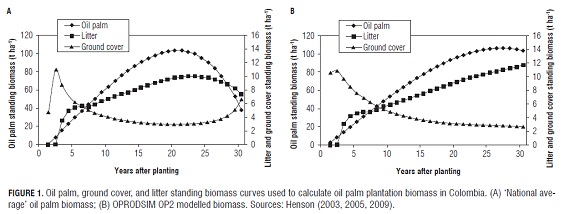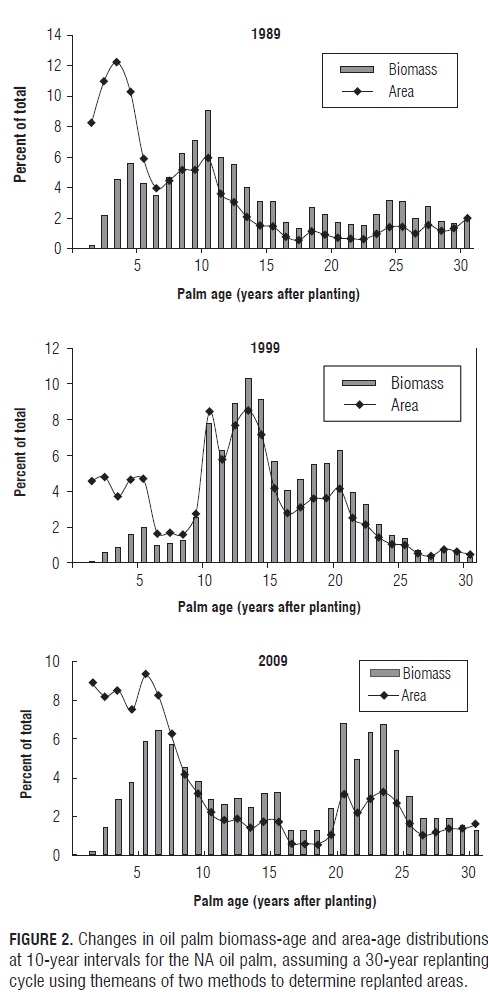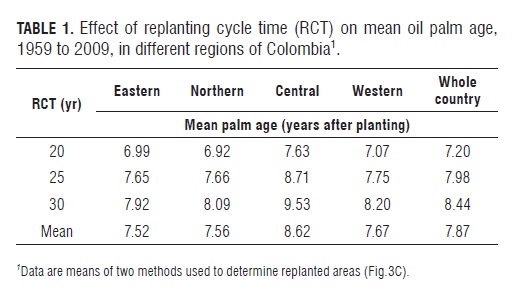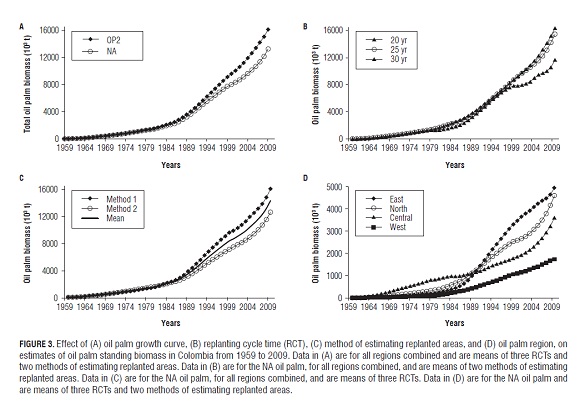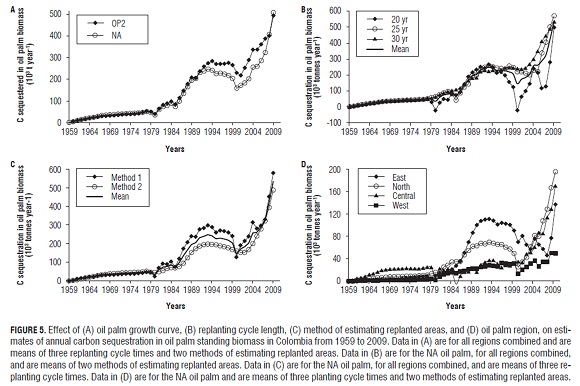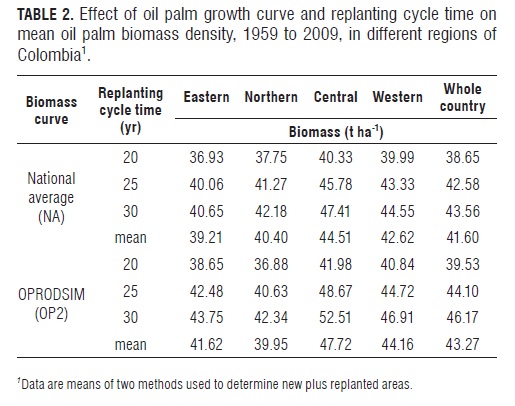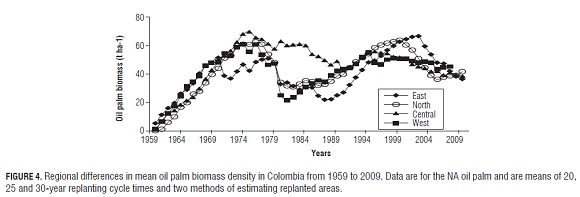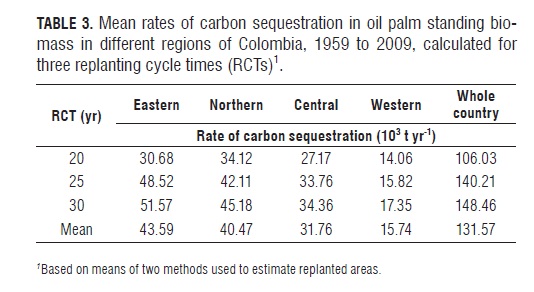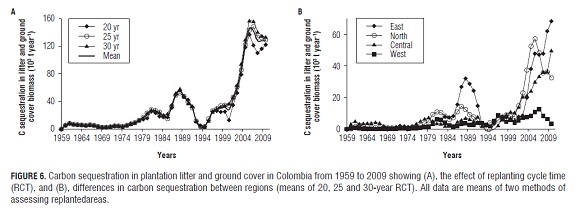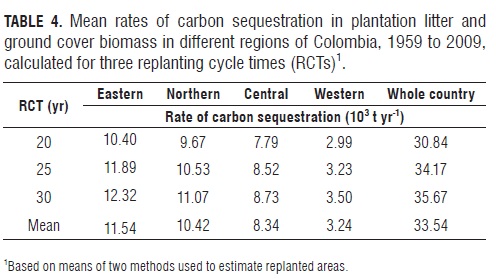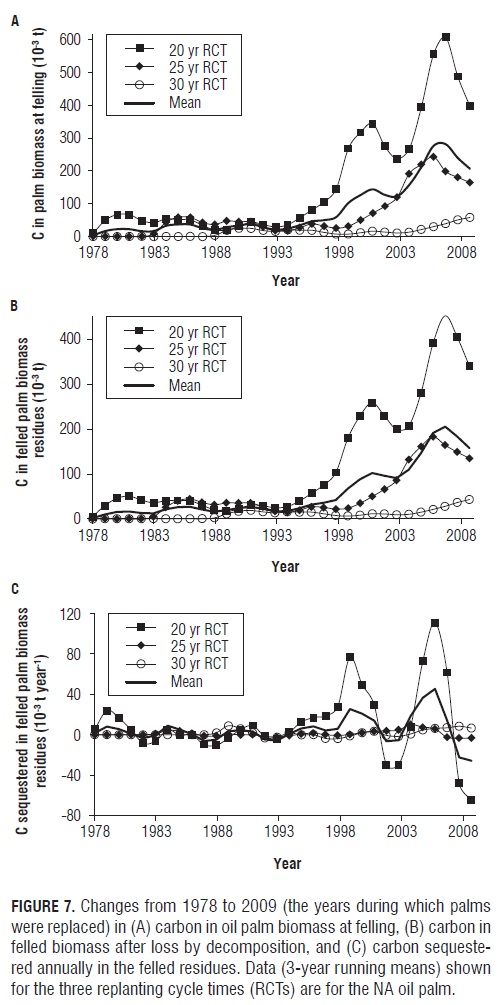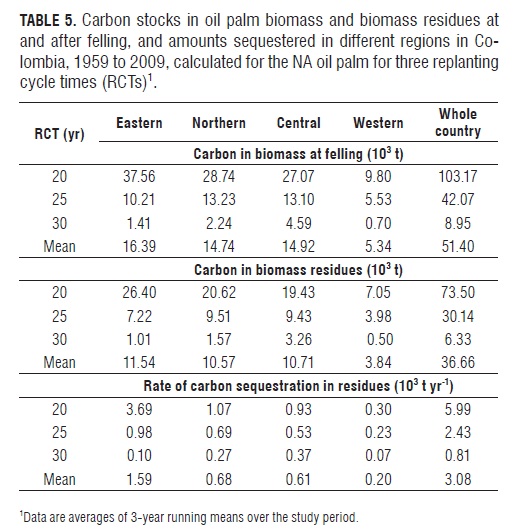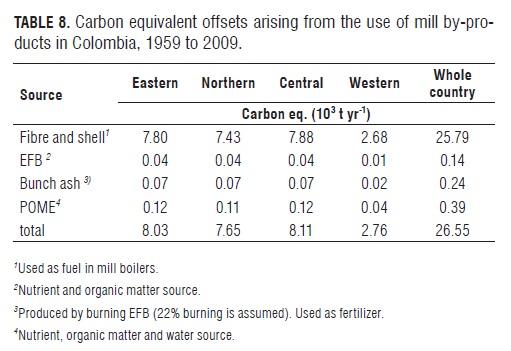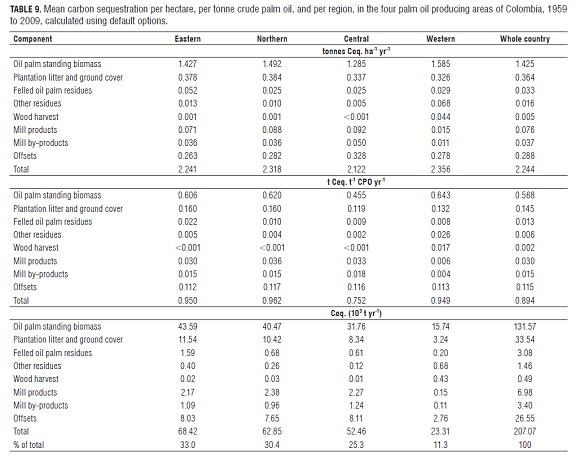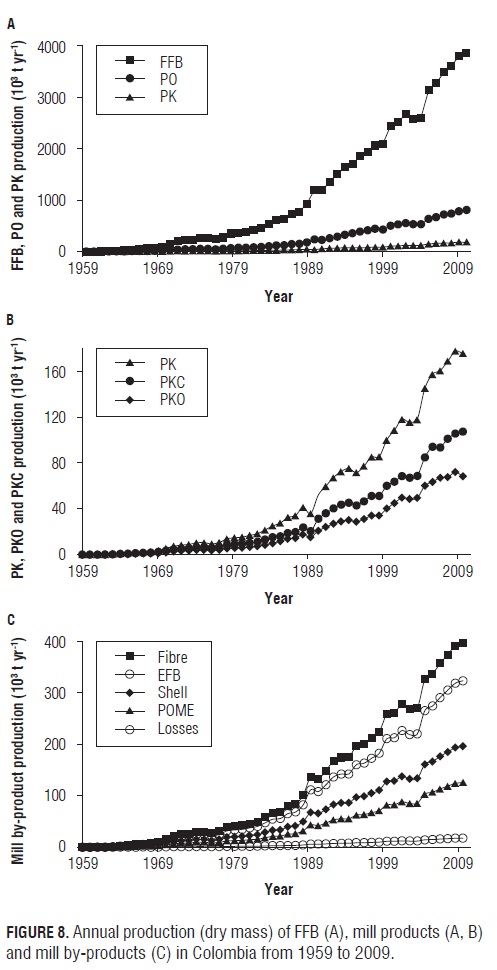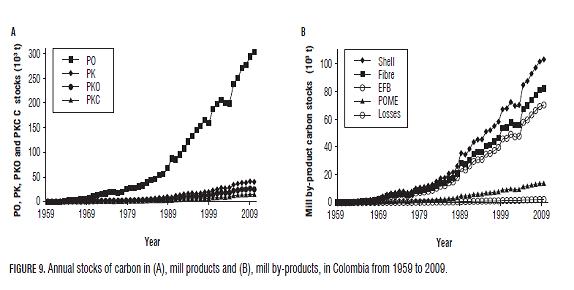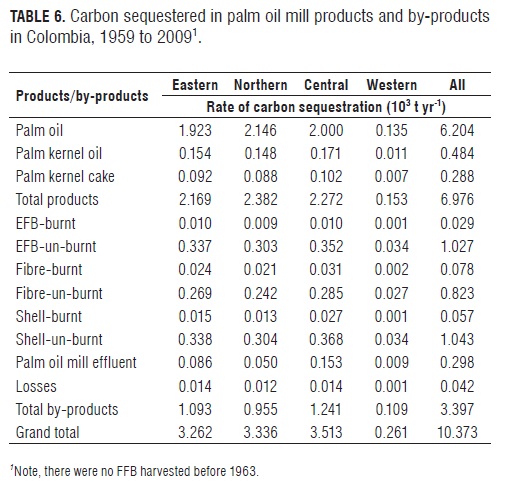Services on Demand
Journal
Article
Indicators
-
 Cited by SciELO
Cited by SciELO -
 Access statistics
Access statistics
Related links
-
 Cited by Google
Cited by Google -
 Similars in
SciELO
Similars in
SciELO -
 Similars in Google
Similars in Google
Share
Agronomía Colombiana
Print version ISSN 0120-9965
Agron. colomb. vol.30 no.3 Bogotá Sept./Dec. 2012
CROP PHISIOLOGY
The greenhouse gas balance of the oil palm industry in Colombia: a preliminary analysis. I. Carbon sequestration and carbon offsets
Balance de los gases de efecto invernadero de la industria de la palma de aceite en Colombia: análisis preliminar. I. Secuestro de carbono y créditos de carbono
Ian E. Henson1, Rodrigo Ruiz R2 and Hernán Mauricio Romero3
1Consultant. Bristol (England).2Oil Palm Biology and Breeding Research Program, Colombian Oil Palm Research Center, Cenipalma. Bogota (Colombia).
3Department of Biology, Universidad Nacional de Colombia. Bogota (Colombia). hmromeroa@unal.edu.co
Received for publication: 11 April, 2012. Accepted for publication: 30 October, 2012.
ABSTRACT
Colombia is currently the world's fifth largest producer of palm oil and the largest producer in South and Central America. It has substantial areas of land that could be used for additional oil palm production and there is considerable scope for increasing yields of existing planted areas. Much of the vegetation on land suitable for conversion to oil palm has a low biomass, and so establishing oil palm plantations on such land should lead to an increase in carbon stock, thereby counteracting greenhouse gas (GHG) emissions responsible for global warming. The first part of this study examines changes in carbon stock in Colombia resulting from expansion of oil palm cultivation together with factors (offsets) that act to minimize carbon emissions. The results are subsequently used to construct a net GHG balance.
Key words: carbon footprint, CO2 balance, carbon stock, land use change.
RESUMEN
Colombia es el quinto productor de aceite de palma en el mundo y el más grande en América Central y del Sur. Tiene áreas sustanciales de tierra que podrían ser usadas para producción adicional de palma de aceite y existe una brecha interesante para incrementar los rendimientos en las áreas existentes. La mayoría de la vegetación de las áreas adecuadas para la conversión a siembra de palma tienen una biomasa baja, de tal manera que al establecer plantaciones de palma de aceite en esas tierras debería incrementarse el carbono almacenado, de tal manera que haya una reducción en las emisiones de gases de efecto invernadero (GHG) responsables del calentamiento global. La primera parte de este estudio examina los cambios en el carbono almacenado como resultado de la expansión del cultivo de la palma de aceite junto con aquellos factores (créditos) que actuan para minimizar las emisiones. Los resultados son subsecuentemente usados para construir el balance neto de GHG.
Palabras clave: huella de carbono, balance de CO2, almacenamiento de carbono, cambio de uso de tierra.
Introduction
Colombia is currently the world's fifth largest producer of palm oil, the second largest producer outside Southeast Asia, and the largest producer in South and Central America. In a previous paper (Henson et al., 2011), we described the growth of the industry in Colombia from the early 1960′s, when detailed records began, up until 2009, when the total planted area in the country was just under 361,000 ha. This is small for a country with a total land area of over 103 million ha, even though much of this lies at altitudes inhospitable to growth of tropical lowland species such as oil palm. Studies on the area of land in Colombia suitable for oil palm (Romero et al., 1999; Mejia, 2000; Rubiano et al., 2009) have indicated a considerable potential for expanding the oil palm planted area, based on climatic, edaphic and topographical considerations. However, there are several additional factors that need to be addressed that may serve to limit such potential growth, such as impacts on food production, biodiversity, carbon stock and greenhouse gas (GHG) emission.
The net impact of a process on climate change is determined by the balance between carbon uptake from the atmosphere, mainly by photosynthesis, and the emission to the atmosphere of GHGs that contribute to global warming. Subtracting sequestered carbon from total GHG emissions expressed in carbon or CO2 equivalents gives the net GHG emission. The main GHGs associated with the cultivation of oil palm and the processing of its products are CO2, methane (CH4) and nitrous oxide (N2O). Assuming a residence time of 100 years, the latter two gases have global warming potentials (GWPs) 25 and 298 times greater per unit mass than CO2.
In this paper, we examine the impact of the oil palm industry in Colombia on the sequestration of carbon in oil palm biomass, palm products and by-products, and evaluate factors that can act to offset or minimize GHG emissions. An accompanying paper will examine emissions and produce a net GHG budget for the industry throughout its development.
Materials and methods
Information on different aspects of the oil palm industry from 1959 to 2009 was gathered from different information sources including the Colombian Federation of Palm Growers (FEDEPALMA), the Instituto Geográfico Agustín Codazzi, and the Colombian Ministry of Environment. The raw data were used to estimate the total GHG balance from the cultivation of oil palm and the milling of fresh fruit bunches (FFB) in Colombia.
The construction of the carbon budget for Colombia closely followed procedures for Malaysia used in an earlier study (Henson, 2008, 2009). We constructed separate budgets for the four regions of Colombia where oil palm is grown (Eastern, Northern, Central and Western), using data for oil palm planted areas and production gathered in a previous paper (Henson et al., 2011).
The main components of a carbon budget are:
- i) carbon sequestration in the oil palm plantation. This includes C in oil palm biomass, ground cover vegetation and litter, including frond piles, detached petiole bases and shed male inflorescences.
ii) carbon sequestration in mill products (palm oil, palm kernel oil and palm kernel cake) and by-products (empty fruit bunches (EFB), palm oil mill effluent (POME), fruit fibre and shell).
iii) carbon emission due to land use conversion to oil palm (loss of carbon during clearance of vegetation).
iv) carbon emission due to direct use of fossil fuels (diesel consumed in plantation vehicles and machinery).
v) carbon emission due to indirect use of fossil fuels consumed in production and transport of inputs such as fertilizers and crop protection chemicals.
vi) carbon equivalent emissions in the form of N2O (mainly produced from inorganic N sources).
vii) carbon equivalent emissions in the form of CH4 produced by POME ponds, mill boilers and plantation livestock.
viii) carbon offsets that serve to reduce emissions such as the use of fibre and shell as fuel for mill boilers, the use of other mill by-products and biomass residues as nutrient sources (thus reducing inorganic fertilizer requirements), and the long-term storage of carbon in any timber harvested during land clearing. Note that other offsets may become important in the near future, notably conversion of CH4 from POME to CO2 by flaring, the generation of electricity from CH4, the use of palm bio-diesel as a fossil fuel substitute, and the production of bio-char from felled trunks, reducing the rate of on-site carbon loss following oil palm replanting.
For this study, carbon sequestration in plantations was calculated based on a) annual values of standing biomass derived using representative curves for oil palm, ground cover and litter (Fig.1), b) biomass-age distributions such as those illustrated for oil palm in Fig.2, and c) conversion of biomass to carbon assuming a carbon content of 45% (Henson, 2009).
There are few, if any, direct measurements of oil palm standing biomass in Colombia but based on mean FFB yields and taking into account the generally conservative nature of oil palm vegetative growth, trends found in Malaysia were assumed to apply and calculations were performed using two contrasting data sets (Fig.1), firstly, the Malaysian "national average" (NA) oil palm based on long-term country-averaged yield performance (Henson, 2003), and secondly, a data set representing a higher yielding crop termed OP2, generated using the Oprodsim model (Henson, 2005). Both sets of data include below-as well as above-ground biomass. To account for all carbon sequestered in the plantations, carbon in the ground cover and litter biomass was added to that in the oil palms. The amounts of carbon in these components were calculated in the same way as that for oil palm, based on biomass changes with age of planting shown in Fig.1
The production data on which estimates were based were obtained from FEDEPALMA (2010 and earlier editions). It should be noted that amounts of PKO and PKC given by FEDEPALMA add up to less than the amounts of PK from which they are derived (ca. 89%), representing losses due to incomplete extraction and loss of residual moisture. Amounts of by-products were derived as fractions of bunch dry matter remaining after extraction of CPO and PK. The proportions of each by-product were based on median values given by Wood and Corley (1993). Remaining residual amounts were assigned as unidentified losses.
Carbon sequestration in mill products and by-products was calculated using carbon contents, estimated lifetimes and, in the case of fibre, shell and EFB, the proportions of materials burnt, given by Henson (2004, 2009). It was assumed that 22% of EFB was burnt to produce bunch ash and 46.8% of both fibre and shell were used in the mill as boiler fuel. The mean quantities present during any year were calculated assuming linear rates of utilization or decay. Burnt material was assumed to have a lifetime one-tenth that of un-burnt. No allowance was made for possible field application of by-products that might affect their decomposition rates and the amounts of carbon sequestered.
Results and discussion
Carbon sequestration in oil palm plantations
Changes in biomass and carbon stock during the oil palm life cycle
During development, oil palms accumulate carbon both in living biomass and in the litter they produce, which mainly comprises cut fronds, shed frond bases and male inflorescences. Carbon is also stored in the ground cover vegetation and in soil organic matter (SOM). Little is known of changes in SOM concentration during the establishment and growth of oil palm. There is evidence for both considerable soil carbon losses at clearance and for increases in SOM as plantations age (Henson, 2004). Because of such uncertainty, this aspect is omitted in the present analysis. The palms themselves generally contain about 85% of the total plantation non-SOM carbon store (Henson, 2009).
Standing biomass of the NA oil palm (Fig.1 A) declines in later years due to stand losses resulting from age and disease (mainly basal stem rot in Malaysia and bud rot in Colombia), augmented by loss of frond bases. The stand density of OP2 oil palm (Fig.1 B) is maintained until clearance, which in some cases may be up to 30 years after planting the palms.
Changes in mean age and biomass of oil palm plantations From annual data on planted areas combined with changes in biomass with palm age, area-age and biomass-age distributions were derived annually for the different oil palm regions and for Colombia as a whole. Examples for the whole country are shown in Fig.2. The distributions are affected by both expansion into newly planted palm areas and by the areas of old palms that are replanted. Two methods were devised to estimate replanted areas (Henson, 2003). These depend on the age at replanting termed the replanting cycle time (RCT), for which there are generally no records, on either a regional or a national basis. RCT can be quite variable but usually ranges from 20 to 30 years. Because of this, the calculations were performed for alternative periods of 20, 25 and 30 years. The mean palm ages resulting from these assumptions are shown in Tab.1.
In addition to RCT, the oil palm growth curves used (NA and OP2) and the method of estimating annually replanted and newly planted areas (Henson, 2003) affect the estimation of biomass density (t ha-1) and the total standing biomass in each region, needed to calculate carbon sequestration. The effects of such factors on total standing biomass are shown in Fig.3.
The biomass curve (Fig.1 A) had a substantial effect on total standing biomass in later years, with the OP2 oil palm having greater total biomass (Fig.3 A), and hence greater carbon sequestration (Fig.5 A) than the NA palm. Both mean palm age (Tab.1) and palm biomass density (Tab.2) increased in all regions as RCT was extended, with the increase in biomass being somewhat greater with the OP2 than with the NA oil palm. Differences between 25 and 30-year RCTs were smaller compared with differences between 25 and 30-year cycles (Fig.3 B). The assessment method options for the replanted area (Fig.3 C) also had an effect on the oil palm standing biomass, with the two methods giving divergent estimates in later years.
Differences in total standing biomass between regions (Fig.3 D) reflected both differences in planted areas and in mean oil palm biomass density (t ha-1). The latter changed substantially over time (Fig.4). In the early years, biomass density was low since most palms were young. After reaching a peak in the mid-seventies, density in most regions declined before increasing again to a peak prior to a second decline. The Central region showed the most stability. Declines indicate periods of increased replanting while increases in density resulted from reduced replanting. In the last ten years or so, biomass density fell in all regions, consistent with the decrease in the mean palm age noted previously (Henson et al., 2011).
Changes in carbon sequestration in oil palm plantations
Mean sequestration rates given for different RCTs and regions in Tab.3 reveal large regional differences, with the highest rates in the Eastern and Northern regions.
Annual changes in carbon sequestration are shown in Fig.5. Carbon loss occurred in 1980 and 2000 with 20-year cycles but otherwise carbon was sequestered in each year, mainly due to continued increase in planted area.
Results for the NA oil palm are given in Tab.4 and Fig.6. Carbon sequestration in ground cover and litter averaged c. 25% of that sequestered in the palms, higher than the 19% found for Malaysia (Henson, 2009).
Carbon sequestration related to previous land use
Existing oil palm areas: oil palm-to-oil palm replanting
Additional, but albeit short-term, carbon sequestration occurs in the residual palm biomass left on-site after felling the old crop. The amount of carbon sequestered in the felled material was calculated as described by Henson (2009), based on previously observed rates of biomass decomposition. The majority of residues disappear within one to two years under moist tropical conditions (Khalid et al., 2000). The calculations ignore the possible use of fire for clearing, now generally discouraged. Burning would cause a rapid release of carbon and result in emissions of other GHGs besides CO2.
The amount of residual material in any one year depends strongly on RCT (Henson, 2009), with long cycles resulting in the least carbon sequestration. Thus, there is considerable uncertainty in the estimated amounts of carbon sequestration in felled material, which for the NA oil palm varied from ten to <1% of the carbon sequestered in the living palms when RCT was changed from 20 to 30 years (Tab.5, Fig.7).
One cause of the lower felled biomass with longer RCT is the decline in biomass with age that is a marked feature of the NA oil palm (Fig.1 A). However, this only partly explains the reduction, as there was a similar, but albeit less pronounced,decline with the OP2 oil palm, even though there was no marked decline in its biomass with age (data not presented).
New oil palm areas: clearance of previous vegetation While most of the carbon in biomass present in areas newly cleared for oil palm planting will, as for oil palm, be rapidly lost, some will be retained on-site in amounts that vary with the initial quantity of biomass, its chemical composition, and the conditions during decomposition.
In the case of forests, carbon may also be stored in timber collected during felling.
In Malaysia, the carbon sequestered in biomass residues and timber was small in relation to total carbon sequestration (5.1% in residues and 3.0% in timber; Henson, 2009), despite a high proportion of forest being present in the areas cleared. In Colombia, the proportion of total carbon sequestered this way is likely to be even lower, given that much of the land converted to oil palm contained low initial biomass. Due to the sparseness of data, a detailed analysis was not possible but rough calculations based on likely previous land use (Tabs.8 and 9) suggest sequestration in residues to amount to no more than 1.46·103 t carbon year-1 or c. 0.7% of total carbon sequestration. For harvested timber (assuming as for Malaysia a 10% timber yield and exponential decay over a 30-year period), sequestration was calculated to be 0.487·103 t carbon year-1, 89% of which was from the Western region.
Carbon sequestration in mill products and by-products
Carbon is sequestered or stored temporally in both the products of FFB milling; crude palm oil (CPO), palm kernel (PK), palm kernel oil (PKO) and palm kernel cake (PKC), and the by-products; empty fruit bunches (EFB), fibre, shell and palm oil mill effluent (POME). Yearly production of FFB, mill products and by-products are given in Fig.8. Changes in standing stocks of carbon in mill materials, after allowing for decomposition and consumption, are shown in Fig.9. Tab.6 gives the mean annual values over the period studied for the four regions and for Colombia as a whole. Total sequestration was roughly proportional to land areas cultivated, but there were some differences between regions on a per hectare basis (Tab.7). Approximately two-thirds of the carbon sequestered was in the products.
Carbon emission offsets
Henson (2009), considered three factors that could offset the emission of CO2 and other GHGs resulting from palm oil production: i) the use of fibre and shell as boiler fuel to generate energy for running the mill, ii) the use of mill by-products as a source of nutrients, thus reducing the need for inorganic fertilizers, and iii) the generation of energy by burning methane (biogas) emitted from POME Biogas production is yet to be actively pursued in Colombia, although plans to promote it have been initiated (Fede - palma , 2009). The present analysis is therefore confined to the other two factors.
Offsets arising from mill by-product use
The principle offset (Tab.8) is the use of fibre and shell as boiler fuel. This serves to provide most, if not all, of the energy needed to run the mill. Even then, not all the potential energy from these sources is recovered. Other uses of mill by-products, such as field application of EFB and POME to supply nutrients and organic matter, contribute only a relatively small extent towards offsetting carbon losses. If EFB is burnt, the produced bunch ash can also serve as a fertilizer, although this practice is being phased out based on broader environmental grounds.
Potential for further offsetting fossil fuel use
There are several other possible means of reducing fossil fuel use that have yet to be fully exploited, and while not presently included as items in the carbon budget, they may well become important in the future. Four such items are considered briefly here.
Use of nutrients from biomass residues resulting from land-use change
Biomass residues of previous vegetation contain nutrients that are released during decomposition, which could serve as sources for newly planted palms, thus reducing the need for inorganic fertilizers in early years of growth. In practice, this factor has seldom been taken into account due to the uncertainty of the uptake efficiency of young palms with restricted root systems. Research is required to quantify this potential nutrient source and devise means of handling residues, so as to maximize nutrient recovery.
Collection and use of methane emitted from POME ponds
There is considerable potential for trapping biogas and using it to generate electricity and at the same time reduce methane emissions to the atmosphere. Several schemes to do this have recently been initiated in Colombia (Fede - palma , 2009).
Production of biodiesel
There are now several biodiesel plants in Colombia. The impact of biodiesel production on GHG balance needs, however, to be carefully analyzed, as it can be either positive or negative depending on the land use change (LUC) during establishment of plantations. In cases that involve clearance of sites with high carbon stocks, biofuel production can increase, rather that decrease, GHG emissions (Danielsen et al., 2008; Fargione et al., 2008).
Production of biochar
It is possible to reduce the rate of carbon loss during land clearing by producing biochar, a long-lived form of carbon resistant to decomposition, from the residues. The process involves controlled, on-site, burning. Studies to evaluate and optimize the process are currently in progress (Garzón, 2009).
Total carbon sequestration
The amounts of carbon sequestered in various forms during the expansion of oil palm cultivation in Colombia are shown in Tab.9. These values were obtained using "default" options, namely the NA oil palm growth curve, a mean of 20, 25 and 30-year replanting cycles, and a mean of the two methods of estimating areas of replanting. These options are considered either the most likely or the least extreme of the possible alternatives. Lower values of sequestration were obtained using a 20-year RCT and higher values using a 30-year RCT or the OP2 growth curve (Fig.3). The effects of alternative scenarios on sequestration rates are further presented and discussed in part II of this paper in the context of the total carbon budget.
The oil palms formed the largest "sink" for carbon followed by the other plantation components (litter and ground cover) and the various offsets. Mill products and by-products contributed much less. On a per hectare basis, there was little difference between the four growing regions in the amounts sequestered, so that the totals for each region mainly reflected the area under cultivation. On the other hand, partly due to yield differences (Henson et al., 2011), sequestration per tonne of CPO was lower in the Central region than in the other regions.
Conclusions
This report is part of a preliminary estimate of the total GHG balance that results from the cultivation of oil palm and the milling of FFB in Colombia. It sought to identify the relative importance of the various forms of sequestration and highlight the uncertainties of the analysis. Hopefully, this should promote further investigations aimed at improving the estimation of carbon sequestration.
The quantification of sequestration, however, is only part of the process of producing a full account of the GHG balance. To complete the process, we also need to quantify GHG emissions. This is the subject of the second paper in this series, leading to the presentation of the full GHG budget.
Literature cited
Danielsen, F., H. Beukema, N.D. Burgess, F. Parish, C.A. Bruhl, P.F. Donald, D. Murdiyarso, B. Phalan, L. Reijnders, M. Struebig, and E.B. Fitzherbert. 2008. Biofuel plantations on forested lands: double jeopardy for biodiversity and climate. Conserv. Biol. 23, 348-358. [ Links ]
Fargione, J., J. Hill, D. Tilman, S. Polasky, and P. Hawthorne. 2008. Land clearing and the biofuel carbon debt. Science 319, 1235-1238. [ Links ]
Fedepalma , Federación Nacional de Cultivadores de Palma de Aceite. 2009. Leaflet. What oil palm has to offer. Bogota. [ Links ]
Fedepalma , Federación Nacional de Cultivadores de Palma de Aceite. 2010. Statistical Yearbook and earlier editions. Bogota. [ Links ]
Garzón, E.M. 2009. Potential use of bio-coal as a soil improvement measure. p. 42. In: Proceedings of XVI International Oil Palm Conference. Fedepalma; Cenipalma, Cartagena, Colombia. [ Links ]
Henson, I.E. 2003. The Malaysian national average oil palm: concept and evaluation. Oil Palm Bull. 46, 15-27. [ Links ]
Henson, I.E. 2004. Modelling carbon sequestration and emissions due to oil palm cultivation and associated land use change in Malaysia. MPOB Technol. 27, 51. [ Links ]
Henson, I.E. 2005. OPRODSIM, a versatile, mechanistic simulation model of oil palm dry matter production and yield. pp. 801-832. In: Proceedings of PIPOC 2005 Agriculture, Biotechnology and Sustainability Conference. Malaysian Palm Oil Board, Kuala Lumpur. [ Links ]
Henson, I.E. 2008. The carbon cost of palm oil production in Malaysia. The Planter 84, 445-464. [ Links ]
Henson, I.E. 2009. Modelling carbon sequestration and greenhouse gas emissions associated with oil palm cultivation and land-use change in Malaysia. A re-evaluation and a computer model. MPOB Technol. 31, 116. [ Links ]
Henson, I.E., R. Ruiz, and H.M. Romero. 2011. The growth of the oil palm industry in Colombia. J. Oil Palm Res. 23, 1121-1128. [ Links ]
Khalid, H., Z.Z. Zin, and J.M. Anderson. 2000. Decomposition processes and nutrient release patterns from oil palm residues. J. Oil Palm Res. 12, 46-63. [ Links ]
Mejia, J.O. 2000. Cenipalma internal report. Centro de Investigación en Palma de Aceite (Cenipalma), Bogota. [ Links ]
Romero, C., A. Moreno, and F. Munevar. 1999. Evaluación edafoclimática de las tierras del trópico bajo colombiano para el cultivo de la palma de aceite. Cenipalma; Corpoica, Bogota. [ Links ]
Rubiano, D.J., G. Corzo, M. Fadul, A. Palacios, C. Martin, E. Boohorquez, S. Ramirez, L. Gomez, C. Sarmiento, and K. Arcilaburgos. 2009. Zonas ambientalmente aptas para el cultivo de la palma de aceite en Colombia. Ministerio de Ambiente, Vivienda y Desarrollo Rural, Bogota. [ Links ]
Wood, B.J. and R.H.V. Corley. 1993. The energy balance of oil palm cultivation. pp. 130-143. In: Proceedings of 1991 PORIM International Palm Oil Conference, Agriculture. Palm Oil Research Institute of Malaysia, Kuala Lumpur. [ Links ]













